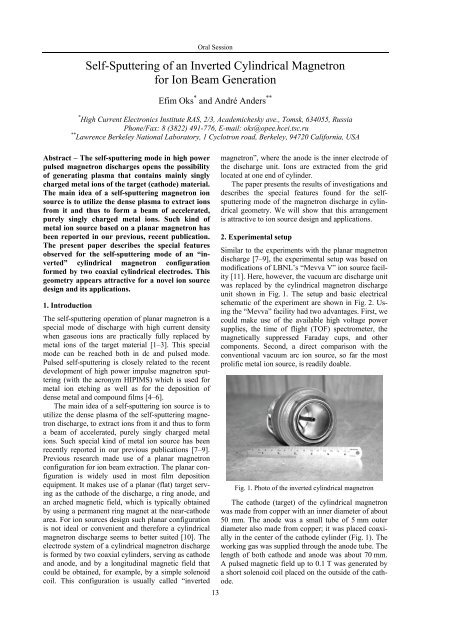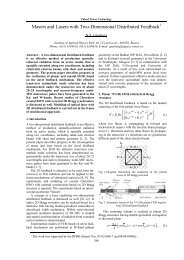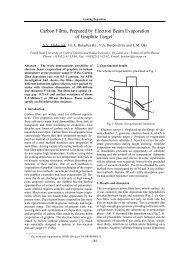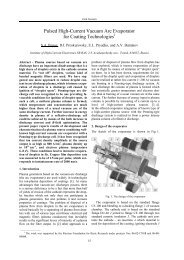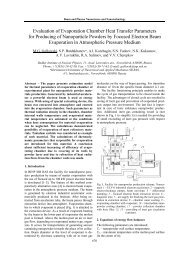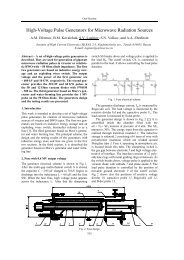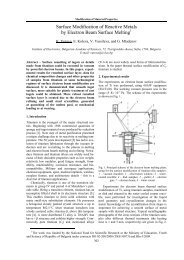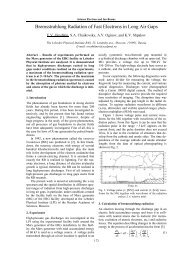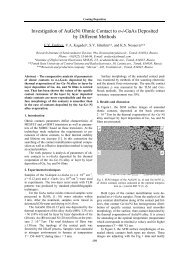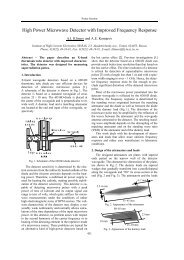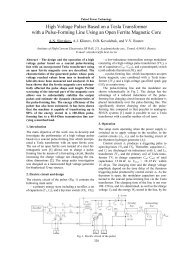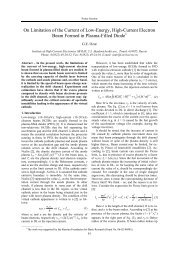Self-Sputtering of an Inverted Cylindrical Magnetron for Ion Beam ...
Self-Sputtering of an Inverted Cylindrical Magnetron for Ion Beam ...
Self-Sputtering of an Inverted Cylindrical Magnetron for Ion Beam ...
Create successful ePaper yourself
Turn your PDF publications into a flip-book with our unique Google optimized e-Paper software.
Oral Session60 mA <strong>for</strong> the cylinder case even when the dischargecurrent exceeded 90 A.7260483624120Discharge current, AdischargeFC ion beam current, mAion beam200 300 400 500 600 700 800Time, μsFig. 4. Pulse shapes <strong>of</strong> discharge current <strong>an</strong>d beam current.Ar, p = 8 ⋅ 10 –5 torr. U a = 30 kVFigure 5 presents the radial distribution <strong>of</strong> the ionbeam current density as measured with a movableFaraday cup. Unlike to the pl<strong>an</strong>ar magnetron case, thering discharge structure is not visible in the cylindricalmagnetron.<strong>Ion</strong> beam current density, mA/cm 21.61.41.21.00.80.60.40.20.00 2 4 6 8 10 12Dist<strong>an</strong>ce from center, cmFig. 5. Radial distribution <strong>of</strong> the ion beam current density.p = 8 ⋅ 10 –5 torr. I d = 90 AThe next two figures, Figs. 6 <strong>an</strong>d 7, present the results<strong>of</strong> experiments investigating the development <strong>of</strong>the ion beam’s charge state composition during thedischarge pulse. The results show <strong>for</strong> the cylindricalmagnetron case that it is possible to reach conditionswhen metal ions dominate over the gaseous ions.However, the situation is not as clear cut as it waswith the pl<strong>an</strong>ar magnetron.The gas ions were displaced <strong>an</strong>d replaced later inthe pulse when considering the inverted cylindricalmagnetron compared to the pl<strong>an</strong>ar magnetron casethen <strong>for</strong> the flat magnetron case. Additionally, theratio <strong>of</strong> metal to gas ions is remains smaller <strong>for</strong> thecylindrical magnetron. This may well be associatedwith the directionality <strong>of</strong> the sputtering process where484032241610 kV, total beam current 25 mA20 kV, total beam current 55 mA30 kV, total beam current 60 mA80sputtered atoms are preferentially emitted normal tothe target surface, generally obeying a cosine-like <strong>an</strong>gulardistribution.Fig. 6. Time-<strong>of</strong>-flight (TOF) ion beam spectrum. Ar,p = 8 ⋅ 10 –5 torr, I d = 90 A, U a = 30 kV, measured 250 µsafter discharge ignition<strong>Ion</strong> fractions, normalized1.00.80.60.40.20.01.00.80.60.4TOF FC current, normilizedC + N 2 + Cu 2+ Ar + Cu +2 3 4 5 6 7Time, μsDischargeCu +0.2Ar +20Ar 2+ Cu 2+0.000 50 100 150 200 250 300 350 400Time, μs100Fig. 7. Temporal development <strong>of</strong> metal <strong>an</strong>d gaseous ionbeam fractions corresponding to the discharge current pulseshape. Ar, p = 8 ⋅ 10 –5 torr, I d = 90 A, U a = 30 kV4. ConclusionsThe results obtained with <strong>an</strong> inverted cylindrical magnetrondischarge follow the general trends previouslyseen with a pl<strong>an</strong>ar magnetron operating in selfsputteringmode. The cylindrical magnetron featuresself-sputtering <strong>an</strong>d c<strong>an</strong> serve as the feedstock plasma<strong>for</strong> <strong>an</strong> ion source. In both cases, metal ions c<strong>an</strong> beextracted. However, the inverted cylindrical magnetrondischarge delivers lower ion extraction current,<strong>an</strong>d the discharge <strong>an</strong>d ion current exhibits greaternoise (fluctuations) <strong>an</strong>d instabilities. There is a need tooperate at much higher discharge currents due to thegreater cathode area, this, however, is limited by theincreasing likelihood <strong>for</strong> a glow to arc tr<strong>an</strong>sition. Inthe present configuration it was shown that the pulsedmagnetic field c<strong>an</strong> be used to trigger the dischargepulses. However, such field may not be optimized <strong>for</strong>ion source operation.806040Discharge current, A15
<strong>Beam</strong> <strong>an</strong>d Plasma SourcesReferences[1] R.C. Krutenat <strong>an</strong>d W.R. Gesick, J. Vacuum Sci.Technol. 7, S40 (1970).[2] N. Hosokawa, T. Tsukada, <strong>an</strong>d H. Kitahara, Effect<strong>of</strong> discharge current <strong>an</strong>d sustained self-sputtering,in Proc. 8th Int. Vacuum Congress, Le Vide,C<strong>an</strong>nes, Fr<strong>an</strong>ce, 1980, pp. 11–14.[3] W.M. Posadowski <strong>an</strong>d Z. Radzimski, J. Vac. Sci.Technol. A 11, 2980 (1993).[4] A. Anders, J. Andersson, <strong>an</strong>d A. Ehiasari<strong>an</strong>,J. Appl. Phys. 102, 113303 (2007).[5] J. Andersson, A.P. Ehiasari<strong>an</strong>, <strong>an</strong>d A. Anders,Appl. Phys. Lett. 93, 071504 (2008).[6] J. Andersson <strong>an</strong>d A. Anders, Appl. Phys. Lett. 92,221503 (2008).[7] E. Oks <strong>an</strong>d A. Anders, J. Appl. Phys. 105, 093304(2009).[8] A. Anders <strong>an</strong>d E. Oks, J. Appl. Phys. 106, 023306(2009).[9] E. Oks <strong>an</strong>d A. Anders, Rev. Sci. Instrum. 81,02B306 (2010).[10] N.V. Gavrilov, G.A. Mesyats, S.P. Nikulin,G.V. Radkovskii, A. Elkind, A.J. Perry, <strong>an</strong>dJ.R. Treglio, J. Vac. Sci. Technol. A 14, 1050(1996).[11] I.G. Brown, Rev. Sci. Instrum. 65, 3061 (1994).16


